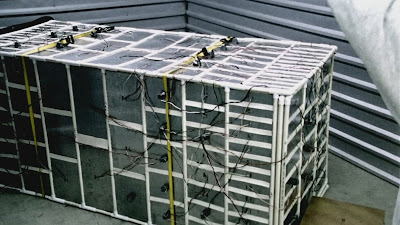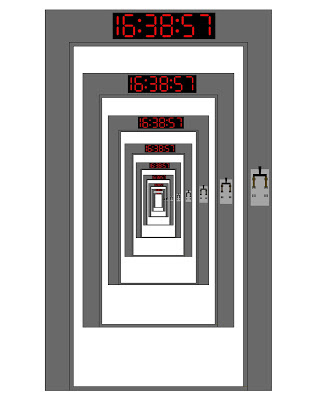Time
travel, let’s talk about it. First off, to deal with causality crises and
paradox problems, I’m going to assume infinite alternate universes, so
as soon as you arrive in the past the universe divides at that point, therefore
your actions are occurring in a new universe and can’t have effects on your
personal past. With that out of the way we can focus on the physics and not the
metaphysics. This post will cover three methods of time travel, their
consequences, and some bonus conjectures from me. I should point out that this
is specifically about traveling back in time, since traveling forward in time
is possible with simple relativistic effects according to the current theories
of physics, and is therefore isn't as fun to talk about.
In fiction time
travel is often shown as using some vehicle (DeLorean, Telephone Booth, Police Box, Steam Punk Contraption) where you punch in
a date, watch some flashing lights, and then drop into your desired time period
out of thin air. Sadly, I don’t think this is physically possible. In the
generally accepted model of the universe, space and time are two aspects of the
same thing (spacetime), and movement in this model is somewhat limited.
To travel from one point to another, you need to travel through all the points
in between. This means that to travel backward through time you should need to
travel through all the corresponding spacetime, or more simply, your time machine
needs to exist in all the space and time between your arrival and departure.
Imagine building a machine, waiting a year, stepping into it and then stepping
out the day after you finished building it. This may not sound very interesting,
unless you’ve ever seen the movie Primer, which uses time travel this
way and is great, if in a more cerebral way than less feasible time travel
films. By the way, you may need to spend the same amount of time in the machine
as is moved back in time, aka, traveling a month into the past involves sitting
in a box for a month. This method would probably be best for short trips, and even then
isn’t useful for much beyond sports betting and day trading in the stock
market.
 |
| A viable time machine has its own special kind of charm |
Another
method for traveling through time involves wormholes, which are always
exciting. The general idea is to make a wormhole, move one end around at near
the speed of light, then take advantage of the relativistic effects to time
travel. To visualize this, picture two doorways that when walking through one,
you instantly walk out of the other, regardless of the distance between them
(feel free to add some extra sciency stuff around the doors to this picture. I
recommend Tesla Coils). Now, similar to the Twin Paradox, you put
one door in a spaceship and fly it around at near light speed for a while. Time
at both doors is tracked, probably in a handsome LED display above the frame, and
when you bring them back together they show a difference of five hours. In
theory, if you where to look at one clock, step through the corresponding door, and then look
at the clock of the door you just excited, you would see the same time (plus a
few seconds naturally). You can’t travel to a time before the wormholes
existing, so you can’t use this to blow Isaac Newton’s mind (unless you find
some existing wormholes that somehow pulled this off naturally), but I still
think this is stupendous. A potential problem with this is that you could create
infinite feedback loops, which are generally bad. An example would be if you
had wormholes one minute separate in time and facing each other at a distance
of one light minute. If you were to shine a light from the older door into the
younger it would emerge at the same time and place it originated, creating an
infinite loop. Infinite energy created through this could maybe break the universe, but I’m not sure if it would be a
problem. Interacting with this energy, including just observing it, would necessarily
interrupt the loop at the beginning, negating the whole thing and making it of
no consequence (unless it just instantaneously ends the universe, which is a lame
consequence, so who cares). A cool thing that you could do similar to this
would be to position the sides of a wormhole in such a way that falling through
one would reposition you directly above it again (no time differences, since it
would just cause problems). This would create an infinite fall, or technically,
an infinite source of potential energy. You could easily run water
through this, set up a turbine, and then generate electricity like mad (I
wonder if this is how Aperture Science gets its power?). This isn’t creating energy or anything, since it's just using gravity, and if overused it could pull the planet out of orbit or something,
but it could still be handy (I wonder if you could use this to propel a planet
on purpose by basically pulling it with its own gravity?). Wormholes are just
so spectacular that it is hard to think of anything that couldn’t be
accomplished with the ample use of them.
 |
| This is what I imagine an infinite fall wormhole arrangement looking like |
A third way
to travel back in time is based on some physicists having some fun with math.
If you create crazy enough spacetime geometry you can plot a trajectory through
it that would result in exiting before you enter. I don’t know the specifics,
but I assume it involves concepts like negative mass or white holes,
whose existence is dubious. If they do exist, this seems like the only
scientifically legitimate way for someone to travel back in time if a
manufactured device hasn’t already been created. A greatly simplified version
of this is commonly used in the Star Trek universe, so I’m willing to call this
version James T. Kirk approved (you can also create warp drives using this same
kind of spacetime geometry witchcraft). If you want to write a scientifically
accurate story that involves time travel motivated by revenge or fixing the
wrongs of the past, then this method would probably be the best. In the theme
of scientific accuracy you would need to account for the fact that such exotic
spacetime geometries would only exist a large distance from Earth, so you would
need to travel out to it and then back. This would take a while so you better
account for that with some extra time traveling, while also employing cryogenic
stasis or something similar during the commute. Finding these spacetime
phenomena would also be difficult, since if you observed it from a distance it
might not still exist when you arrive at its location. Also, surviving travel
through this space would be difficult do to insane tidal forces and the like. Hmm, maybe you shouldn’t write a
scientifically accurate time travel story. Probably the most interesting thing
here is that physicists are spending time thinking about how to make time machines, which
makes me very happy.
 |
| Looks simple enough to me |
I’ve come
to a conclusion. The best method for traveling back in time would be for aliens
to show up and give you access to a bunch of time machines that they have
spaced throughout the past, preferably using wormholes. I think I’ll just wait
for the wormholes, because they’ll make a when no different than a where, and
that’s a concept so excellent that I can barely handle it.
No comments:
Post a Comment